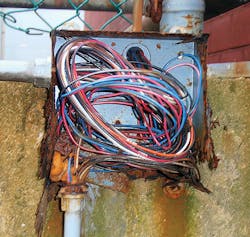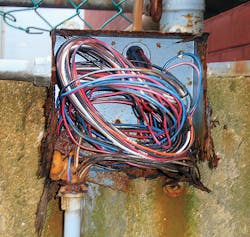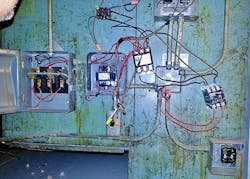Illustrated Catastrophes: Rusty Box and Exposed Live Parts
All references are based on the 2014 edition of the NEC.
Ragged, Rotten, and Rusty
While on vacation on an island in Long Island Sound, Andrew Walter — an engineer for Walter Development Co. — came across this rusted and rotted out junction box at a fuel storage facility. This installation is now a violation of Sec. 110.12(B) because the rust has completely destroyed the enclosure and compromised the integrity and safe operation of this electrical installation. In accordance with 110.11, equipment shall not be used in a damp or wet environment, or where exposed to agents that have a deteriorating effect, unless the components are identified for the specific conditions present in the area. Section 300.6 requires raceways, boxes, supports, and other electrical equipment to be made of materials that are suitable for the environment where they are installed. Obviously, that was not the case with this installation.
Another problem we can cite is the lack of grounding/bonding continuity between the enclosure and the connected raceways. Section 250.96(A) requires metal raceways, enclosures, and other metal non-current-carrying parts to be bonded in a manner that ensures electrical continuity and the ability to safely carry fault current imposed on them. This requirement is no longer being met with this rusted out installation, creating a potentially serious shock and fire hazard. The box cover, which is missing but required by 314.25, only seems to exacerbate the situation.
Southern Exposure
This photo was taken at a grocery store in Memphis, Tenn., and sent to us by Lyle Amundson, president of LA’s Custom Power and Lighting. Unfortunately, I don’t have enough space to describe all of the problems with this installation. However, I will start with the shock hazard created by the exposed energized terminals.
Section 110.27(A) requires live parts, operating at or above 50V, to be guarded against accidental contact by suitable enclosures. Other recognized means include installations accessible to only qualified persons in a room, vault or similar enclosure, or locations behind screens or partitions accessible to qualified people only, or locations on balconies, galleries or similar elevated platforms, where warning signs in accordance with 110.27(C) are installed, forbidding unqualified people from entering any of these spaces. No such spaces existed in this store.
Now let’s focus on the use of exposed single insulated conductors as a wiring means. Section 300.3(A) requires single conductors to be used only where installed as part of a recognized Chapter 3 wiring method, such as a raceway or cable. In addition, the missing box covers are a violation of 314.25. Last, but by no means least, this installation certainly violates the “neat and workmanlike” requirements of 110.12.
About the Author

Russ LeBlanc
Owner
Russ started in the electrical trade as an apprentice in 1985. He worked his way up to become a Journeyman Electrician and then eventually became a Master Electrician and Licensed Construction Supervisor. In 1999 Russ become an Electrical Instructor for The Peterson School of Engineering in Massachusetts where he developed his passion for teaching, and quickly became Department Head of Electrical Instruction. Russ has taught thousands of apprentices, electricians, engineers, inspectors, and other electrical professionals during his career as an instructor. He continues to provide electrical professionals with Electrical Code seminars, Arc-Flash Awareness training seminars and educational material through his LeBlanc Consulting Services in North Reading, MA whose specialty is educating electricians. He has been an active member of the NFPA Electrical Section and has authored hundreds of National Electrical Code proposals and comments which have become Code rules to improve the safety for the electrical industry. Russ is also an IAEI certified Electrical Inspector.
Please visit www.russleblanc.net for more information.


